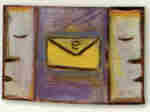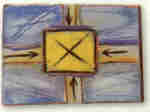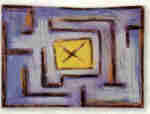reprint from:

enterprise
|
Easy Ways to Botch a WebSite
by Robert Fabian
Not long ago, any company with a website was a pioneer. Today, having a website is a necessity. There has been an explosion of websites. Quantity has increased Dramatically. Quality is something else.
Too many business websites fail to deliver full value. There is no magic formula. My group, WebSiteValue.com, has developed a process to highlight possible value problems. One by-product is a list of easy ways to botch a website.
KEEP PAGE CONTENT LOW
The user experiences a website one page at a time. Each page is a new experience. If the user doesn't find value on a new page, there is a good chance s/he will go somewhere else. User can be incredibly fickle. Don't blindly carry over a splash screen from Windows. On the web, such pages are little more than a "click to enter" button that can take minutes to load. Not a good value proposition. top of list
MAKE CONTACT DIFFICULT
Website value comes from people getting value from what they find on the site. There are always other people standing behind this material. It is natural, and reasonable, for visitors to want to make contact with the people and the organization behind the site. How do I go about calling them? If I want to write them a letter, where should it be sent? If I want to use email, what address should I use? top of list
IGNORE EMAIL
 When site visitors send an email message, it's important to respond. Too often, websites provide an email address that can be used to contact the organization, but no one seems to look at the resulting in-basket. Studies have confirmed that a significant percentage of major sites never answer email. If you don't want to respond, don't provide an email address. But if you don't want user response, why have a website? top of list When site visitors send an email message, it's important to respond. Too often, websites provide an email address that can be used to contact the organization, but no one seems to look at the resulting in-basket. Studies have confirmed that a significant percentage of major sites never answer email. If you don't want to respond, don't provide an email address. But if you don't want user response, why have a website? top of list
FOSTER LINKROT
Central to the web experience are the hyperlinks which seamlessly connect html pages on servers located anywhere in the world. It can be a very positive experience, but the links need to work. Nothing quite matches the frustration of finding the link to a great site and then discovering that the link doesn't work. There may be good reasons for renaming pages on a site, but you should maintain backwards compatible cross-references. top of list
CHANGE DEFAULTS OFTEN
One of the great features of web browsers is that page authors can exert a degree of control over how information is displayed. It's possible to force one page to display with purple letters on a black background, and then force the next page to display with green letters on an orange background. It's possible, but not a good idea. Use default values. If you must change the defaults, do it once. top of list
HIDE THE GOOD STUFF
Users come to a site to get what they believe will be The Good Stuff. It's surprising how many sites make it difficult to find that Good Stuff. No links are provided on the home page to the most popular areas on the site. And when a promising link is provided, the user is expected to click past multiple pages, all lovely in the author's eyes, but irrelevant in the user's eyes. Know what users view as The Good Stuff, and make it easy to get. top of list
PUT DESIGN ABOVE CONTENT
Websites, and especially business websites, are about providing information. Too many business sites focus on a great graphical design, and give short shrift to the information content on those visually attractive pages. The only way for a business site to deliver real value is to provide the information upon which business value depends. Don't ignore design, but content really needs to be king. top of list
BUILD DEADEND PAGES
 Web pages aren't shorn of context and suspended in isolated cyberspace. Users get to a page by following a path, hopefully one the author intended. Users should leave a page by following one of the paths provided by the author. Users should never feel abandoned on a deadend page. At a minimum, pages should have at least a button to take the user back to some natural starting point. top of list Web pages aren't shorn of context and suspended in isolated cyberspace. Users get to a page by following a path, hopefully one the author intended. Users should leave a page by following one of the paths provided by the author. Users should never feel abandoned on a deadend page. At a minimum, pages should have at least a button to take the user back to some natural starting point. top of list
UNDERLINE FOR EMPHASIS
The default for all current browsers is for hyperlinks to appear underlined. Years ago, text was underlined for emphasis, because typewriters didn't offer italic or bold type. Underlining seems to have remained as a vestigial link with that past. It's a silly word processing practice. It's a bad practice on a web page. Users expect underlined text to be links. Don't disappoint your users. top of list
USE ANIMATION FREQUENTLY
There is compelling evidence that animation draws the eye to the moving object. The user must fight that surface distraction to get at the content of the page. It seems as though much animation is present just because it is now possible. The user is to be amazed by the riveting visual effect. The designer feels good. But the poor user is forced to fight her/his way past irrelevant animation. top of list
ENCOURAGE INCONSISTENCY
Users expect to see the same pattern(s) repeated throughout a website. Users should be able to rapidly pick up the meaning of the basic design. This predictability is important to allow users to make efficient and effective use of the site. Whimsically changing the basic design pattern makes sense only for whimsical websites. And projecting a quirky, whimsical image is not in the best interest of most business websites. top of list
HIDE THE LOCATION
 Websites have a way of growing off in all directions. This can be creative. It can also be intensely confusing to users. On many websites, it's all to easy for the user to get lost. S/he has no idea of how s/he got to a particular page, nor where that page lies in the overall scheme of things. Some order should be imposed on the creative chaos. Users will thank you, and your site will deliver greater value. top of list Websites have a way of growing off in all directions. This can be creative. It can also be intensely confusing to users. On many websites, it's all to easy for the user to get lost. S/he has no idea of how s/he got to a particular page, nor where that page lies in the overall scheme of things. Some order should be imposed on the creative chaos. Users will thank you, and your site will deliver greater value. top of list
ALWAYS USE MULTIMEDIA
The web is changing and multimedia no longer imposes an impossible time cost. For the right users, with the right connection to the Internet, carefully chosen multimedia can be effective. A video clip of a part being changed can be very useful. This is a selective use of multimedia. Never use it just because you can. Users will leave if you require a new plug-in just to see your homepage. top of list
USE MEANINGLESS URLS
There is growing recognition that the web is only one way an organization communicates to the outside world. It's common to see print advertisements with a featured web address - the URL for the organization's website. Who will remember: "sambo.bigco.com/F257_7c/gW621_Z.html"? Far better to have: "www.bigco.com/sale/current_item.html". And it isn't that difficult to translate from internal to external URLs. top of list
FORCE YOUR VIEW
A website is, above all else, a way for the organization to communicate with visitors to that site. This form of communication is like all others - the most effective communication starts from the reader's (visitor's) perspective. Too many sites mirror the parent organizational structure and are unconnected to the questions and concerns of visitors. You wouldn't do it in a print advertisement. You shouldn't do it on the web. top of list
OBSCURE PURCHASING PROCESS
You would think that websites offering items for sale would want visitors to buy. It should be easy to start the process. To the extent possible, the user should be kept informed about the progress of her/his order. The process should be clear. Often, however, on-line buying mirrors an obscure internal purchasing process. This may reduce some internal technical problems, but it ain't good business. top of list
RESTRICT ACCEPTABLE BROWSERS
It is certainly convenient for a site to require that everyone use one of the "acceptable" browsers. Developers can take full advantage of the features supported by these browsers. But visitors do not always arrive using one of the acceptable browsers. Many sites refuse to provide service to such visitors. Some browser restrictions are a practical requirement, but it should never be arbitrary. Too often it is. top of list
Our list could be extended. There are other easy ways to botch a website, but they are somewhat less common. And there are a number of technical ways to botch a website, but out list focused on design problems that can be seen. We expect this list to evolve. People can be highly creative in finding ways to mis-apply technology. As business needs and technology change, there will be new and better ways to botch a website. Count on it!
------
Paul Eisen and Peter
Roosen-Runge, of WebSiteValue.com, were particularly helpful in developing
this list.
| 
 When site visitors send an email message, it's important to respond. Too often, websites provide an email address that can be used to contact the organization, but no one seems to look at the resulting in-basket. Studies have confirmed that a significant percentage of major sites never answer email. If you don't want to respond, don't provide an email address. But if you don't want user response, why have a website?
When site visitors send an email message, it's important to respond. Too often, websites provide an email address that can be used to contact the organization, but no one seems to look at the resulting in-basket. Studies have confirmed that a significant percentage of major sites never answer email. If you don't want to respond, don't provide an email address. But if you don't want user response, why have a website?  Web pages aren't shorn of context and suspended in isolated cyberspace. Users get to a page by following a path, hopefully one the author intended. Users should leave a page by following one of the paths provided by the author. Users should never feel abandoned on a deadend page. At a minimum, pages should have at least a button to take the user back to some natural starting point.
Web pages aren't shorn of context and suspended in isolated cyberspace. Users get to a page by following a path, hopefully one the author intended. Users should leave a page by following one of the paths provided by the author. Users should never feel abandoned on a deadend page. At a minimum, pages should have at least a button to take the user back to some natural starting point.  Websites have a way of growing off in all directions. This can be creative. It can also be intensely confusing to users. On many websites, it's all to easy for the user to get lost. S/he has no idea of how s/he got to a particular page, nor where that page lies in the overall scheme of things. Some order should be imposed on the creative chaos. Users will thank you, and your site will deliver greater value.
Websites have a way of growing off in all directions. This can be creative. It can also be intensely confusing to users. On many websites, it's all to easy for the user to get lost. S/he has no idea of how s/he got to a particular page, nor where that page lies in the overall scheme of things. Some order should be imposed on the creative chaos. Users will thank you, and your site will deliver greater value.